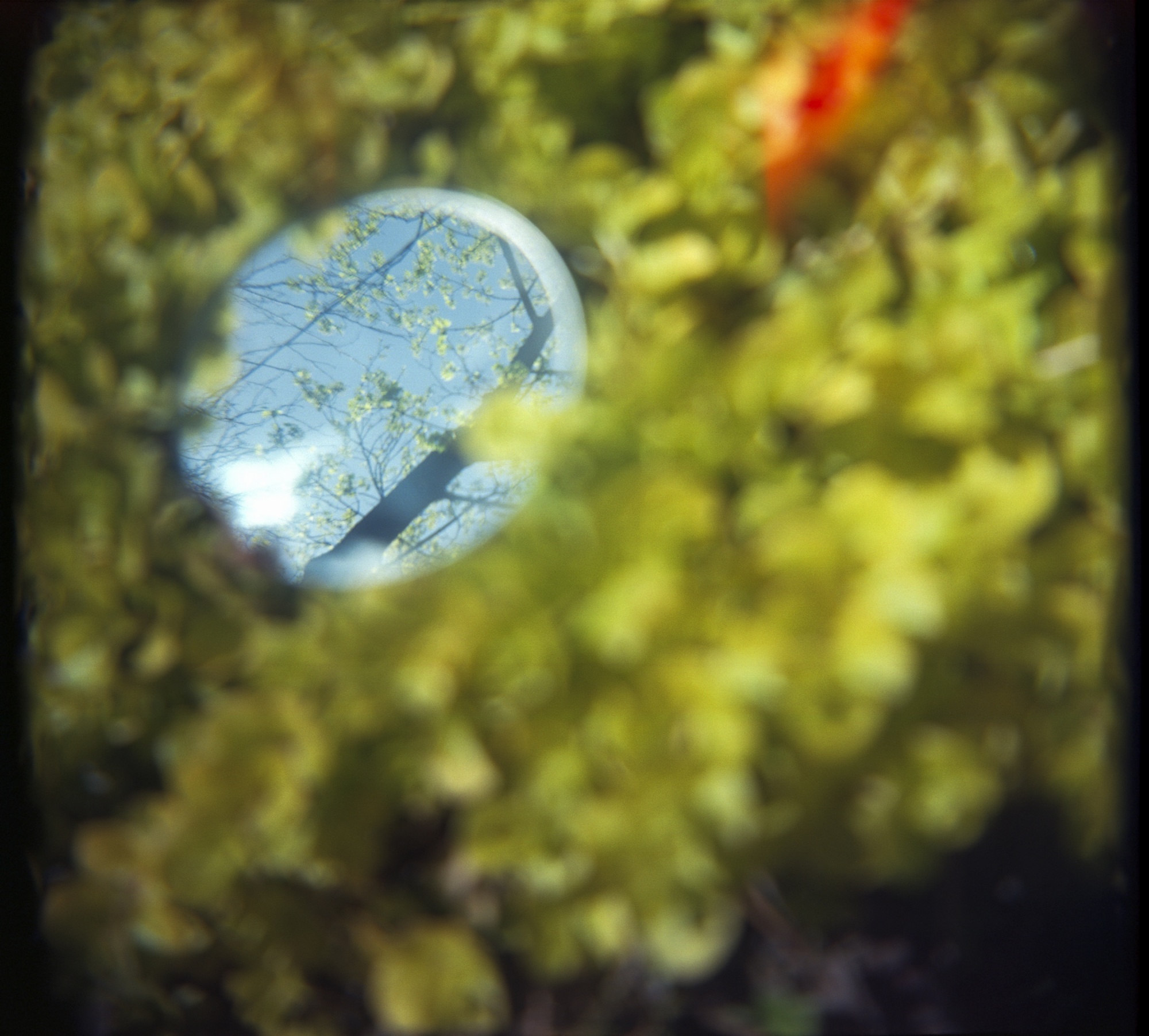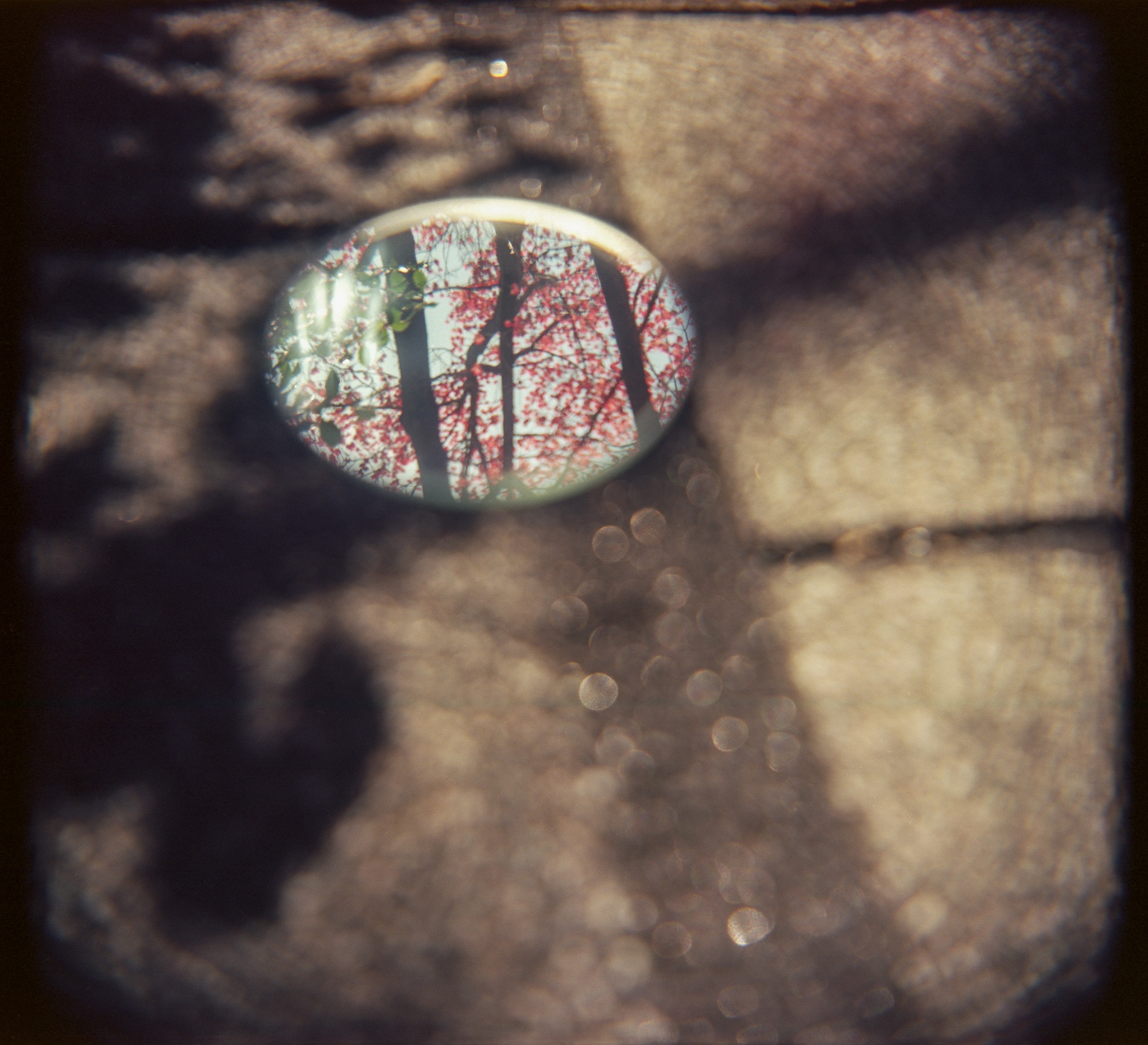This article was part of FORUM+ vol. 32 no. 2, pp. 36-39
The photograph has long been described as a suspension and immobilization of time and space – a crystallization of the world’s incessant manifestation and change, that is to say, of the world’s ever-changing appearances into one single instant. Thinkers such as Roland Barthes (in Camera Lucida)1 and Maurice Merleau-Ponty (in The Visible and the Invisible)2 have shown that a photo never fully captures reality but instead reveals it only partially, through the play of light, framing, and absence. This paradox – between presence and disappearance – has been central to phenomenological approaches to photography.

Reflection I.
In this essay, we return to this paradox not through phenomenology alone, but through an artistic exploration. Yiling Hu’s photographic series Reflection (2024), made using a medium-format Holga film camera, experiments with reflections and framing to examine how photography both shows and conceals the world. These images are not merely about what appears within the frame – they explore what escapes it. We draw inspiration from artists such as Max Pinckers,3 whose work in Controversy reveals the constructed nature of photographic truth, and Uta Barth,4 whose use of focus and framing foregrounds absence and perception itself. These contemporary practices situate our project within a broader inquiry into the act of seeing and the limits of photographic representation.

Reflection II.
We propose the term "photo-phenomenon" to describe this moment of photographic appearing. As we will explicate below, the photo-phenomenon is not just a theoretical construct. It is enacted through a visual strategy that stages disappearance and openness, absence and infinity. These photographs do not seek to represent the world but to gesture toward its constant movement beyond the frame.

Reflection III.
A photo is not just a document of the real but a fleeting condensation of visibility: the point at which both the world and the gaze of the photographer flash into being and vanish in the same instant. In the Reflection series, this appears through the use of mirrors: one reflection traces the orientation of the photographer’s gaze (now absent), while the other opens onto the sky – an infinite expanse that symbolizes the world’s ungraspable totality. In this instant, not only are the appearing things fixed and frozen forever, their existence suspended (for we can never penetrate beyond the photo to the real existence of the things it captures), but the seeing subject – the vantage point from which the frame is oriented – also withdraws, becoming invisible. The camera itself remains absent within the photo, unless its presence is introduced through a different point of view.

Reflection IV.
What, then, does the photo capture in this unfathomable instant, if not the anonymously luminous field of phenomenon in its purest form – devoid of any subject’s testimony and independent of any firm existence? It is the very moment in which a thing both appears and disappears within a single, indivisible instant. Before the instant of the photo, the phenomenon of the thing is on the verge of appearing; after this instant, this very appearance is already beginning to fade. In this precise instant, appearance and disappearance are condensed into an equilibrium of eternity.
+++
This double-movement of appearing and disappearing in one single instant is precisely what the Belgian phenomenologist Marc Richir calls the double-movement of phenomenalization. As he writes:
The movement of unfolding (of going above and beyond, moving away) folds, and it is the folding of the unfolding that phenomenalizes. Being becomes being insofar as, in its unfolding, being folds. This is it, the scription, the tracing. The being is the spark that springs from this double movement of unfolding-folding.5
Phenomenalization, then, is a movement simultaneously going in two directions (appearing and disappearing), from which the real being comes into existence as a sparkle out of the friction inside this double-movement.
However, Richir’s movement of phenomenalization is quite difficult to understand intuitively, since it requires us to think of a movement that paradoxically goes in two directions at the same time. What Richir here refers to as a phenomenon is not simply the appearance of a thing or the intelligent essence of an idea. It is instead the phenomenon as nothing but a phenomenon, that is, the phenomenon that occurs without resorting to anything else (i.e., the thing or the idea as the ground behind the appearance). For Richir, to do phenomenology is to grasp the movement of this radically indeterminate phenomenon based on nothing but itself:
It is therefore, for us, through the radical phenomenological reduction that we propose, a matter of considering the phenomenon solely in relation to its phenomenality, with any pre-existing concept or a priori concept being placed between parentheses or set aside. If we distinguish, by phenomenalization of the phenomenon, that by which and through which the phenomenon comes to appear, and to be seen, as a phenomenon and nothing but a phenomenon, it follows that the consideration of the phenomenon solely in relation to its phenomenality coincides with what we call the problematics of phenomenalization.6
The basic mode of phenomenon’s movement, in its most archaic level (that is, without any conceptual distortion), is, again, precisely this double-movement of appearing and disappearing at the same time. Moreover, if phenomenon, in its purest sense, means nothing but itself, then it is also a kind of nothingness, precisely because no determination can be prescribed to objectify it in advance.
+++
The "photo-phenomenon", in one single capture and one single instant, manifests the way in which phenomenon phenomenalizes itself.
Can we actually ‘see’ this double-movement of phenomenalization out of nothingness? We thus suggest an artistic and intuitive approach – through photography – to grasp such double-movement of phenomenalization in the domain of images, rather than through thought’s pure abstraction. The photo is a manifestation of this pure field of phenomenon, made visible only through the instantaneous act of capturing: an instance of seizing the movement of phenomenalization. This is what we call the photo-phenomenon. It refers to the paradox at the heart of photography: While freezing and capturing the phenomenon as a fixed image in one single instant, the photo also paradoxically reveals the movement of phenomenalization. To distinguish it from pure movement of phenomenalization (movement in itself) – which oscillates in the most archaic layer of reality without any visibility – we coin the term “photo-phenomenon” in order to emphasize that it is inside the photo, instead of the archaic and pre-photographic domain of phenomenon itself, that this movement becomes intuitively visible. It is in the photo, in its luminous field of visibility, that we could ‘see’ the movement of the phenomenon in its most concrete form.
We explore this possibility through the presence of reflections within the photo – not reflections of the seeing subject, the camera, or any preexisting object within the frame, but instead, a double reflection. The double-reflection emerges in two different directions from the surface of a single mirror. One direction reflects the invisibility of the camera and the subjective gaze; the other reflects the absent world, presenting in the mirror in its excess as the infinite horizon.

Reflection V.
First, by confronting the mirror directly with the gaze of the camera, we gesture toward the very invisibility of the seeing subject. The reflection from the mirror’s surface – where the camera ought to appear – reveals instead only the sky. This directs attention back toward the vanishing point of the subject’s gaze. Second, the other direction of reflection draws the viewer toward an opening onto the sky – an infinite expanse where the world is suggested not through representation but through its very impossibility – the impossibility of encapsulating the world within the confines of the frame.

Reflection VI.
This double reflection, rather than merely capturing what is already present within the frame, performs a more radical function: It discloses the absence at the heart of the seeing subject itself. The first reflection – pointing back toward the vanishing point of the subject’s gaze – renders visible the very act of seeing and gazing by forcing the viewer to confront the paradoxical emptiness inside the mirror, where the subject’s gaze or the position of the camera ought to be present. The second reflection – opening onto the sky or an infinite expanse – extends this withdrawal beyond the subject, toward the world as an ungraspable horizon. In doing so, the reflection does not merely show an object but gestures toward what exceeds all representation: the world, which is neither contained within the frame nor fully absent from it, but which conditions the very possibility of the image.

Reflection VII.
Thus, the reflection serves as a paradoxical marker of presence and absence, of visibility and invisibility. It does not offer the world as something given but as something that can only be traced in its withdrawal. Moreover, the double-reflection in two directions at the same time is the very form of the movement of phenomenalization, in the sense that, the invisibility of the gaze and the world is rendered intuitively ‘figurable’ through this movement of double-reflection via the instalment of the mirror in the photo. The photo captures the double-movement of phenomenalization, and the mirror reflects the very process of this encapsulation of movement in an instant. Thus, the mirror, with its reflexibility in double directions, is the means through which we invite viewers to participate within the movement of phenomenalization in the photo-phenomenon.

Reflection VIII.
The photo-phenomenon, in one single capture and one single instant, manifests the way in which phenomenon phenomenalizes itself: how it appears and disappears, how it is contained in reflections, through which the world could be glimpsed and fathomed in its very infinity and openness.
+++
Yiling Hu (she/her)
is an artist and PhD researcher at LUCA School of Arts, KU Leuven. She is an student of philosophy, and her works explore the ontology of digital media and the phenomenology of photography.
Xiaohuan Yu (he/him)
is an independent journalist and philosophy reader with a keen interest in contemporary phenomenology. His recent work focuses on the phenomenology of Marc Richir.
xiaohuan.yu@student.kuleuven.be
All images in this article are made by Yiling Hu, 2024, film photography, Holga medium format camera, Kodak Portra 400.
Footnotes
- Barthes, Roland. Camera Lucida: Reflections on Photography. Translated by Richard Howard, Hill and Wang, New York, 1981. ↩
- Merleau-Ponty, Maurice. The Visible and the Invisible, ed. by Claude Lefort, translated by Alphonso Lingis, Northwestern University Press, Evanston, IL, 1968. ↩
- Pinckers, Max. “Controversy.” Max Pinckers, www.maxpinckers.be/projects/controversy/. Accessed 1 July 2025. ↩
- Barth, Uta. nowhere near. Gregory R. Miller & Co., New York, 1999. ↩
- Richir, Marc. “Le Rien enroulé – Esquisse d’une pensée de la phénoménalisation.” Textures 70/7.8: Distorsions, Bruxelles, 1970, pp. 19-20. ↩
- Richir, Marc. Phénomènes, temps et êtres: Ontologie et phénoménologie. Jérôme Millon, Paris, 1994, pp. 19-20. ↩


